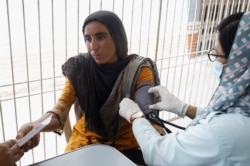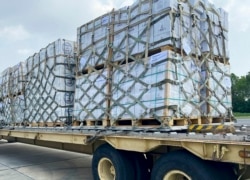Pakistan continues to reel from unprecedented flooding, which killed more than 1,600 people this year, displaced millions, ravaged crops, damaged nearly 2 million homes, and wiped out roads and other infrastructure.
The World Bank has approved $2 billion in aid – the largest such pledge so far.
Amid Pakistan’s woes, U.S. Secretary of State Antony Blinken pushed for engagement with China on debt relief and restructuring “so that Pakistan can more quickly recover from the floods.”
That prompted a harsh response from Chinese Foreign Ministry spokesman Wang Wenbin.
“The Chinese government has provided 400 million RMB ($55.6 million) worth of humanitarian assistance, and China’s civil society has also lent a helping hand. We will continue to do our utmost to help the Pakistani people overcome the floods and rebuild their homes at an early date,” he said.
“China and Pakistan have had fruitful economic and financial cooperation. The Pakistani people know it best. Instead of passing unwarranted criticism against China-Pakistan cooperation, the U.S. side might as well do something real and beneficial for the people of Pakistan.”
Wang’s misleading deflection failed to address the issue Blinken raised about Pakistan’s debt to China. It also ignored the fact that the United States has provided Pakistan with much aid and assistance in the face of the natural disaster.
First, Pakistan’s estimate of flood-related damages – $30 billion – is equal to the amount of money the country owes to China.
According to Bloomberg, that is around a third of Pakistan’s total external debt. And some of this debt is tied up in what Fortune magazine described as “opaque” emergency loans.
China, the world’s largest bilateral lender, has given a total of $32.8 billion in emergency loans to debt-laden Sri Lanka, Pakistan and Argentina, Fortune reported, citing information from AidData at The College of William & Mary in Virginia.
Largely, these loans have been used to prevent default related to China’s Belt and Road Initiative (BRI) – Beijing’s $1 trillion trade and diplomatic program to connect with Eurasia and Africa with Chinese-built infrastructure projects, Fortune said, citing a report by the Financial Times calling China an emerging competitor to the Western-led International Monetary Fund.
Fortune reported:
"[R]esearchers have found that the bulk of China’s overseas lending — around 60% — is now to low-income countries that are currently mired in debt distress, or at high risk of it. Beijing’s pivot to short-term rescue lending highlights its growing role as an emergency lender of last resort, rendering it an alternative to the Western-backed International Monetary Fund (IMF).
"Experts are concerned about what comes next, as many of the nations that took loans from China are facing an extraordinary debt crunch amid an era of inflation and climate change."
Pledged Chinese investment in the China-Pakistan Economic Corridor (CPEC) – a flagship project of the BRI – has been valued at $62 billion.
VOA’s sister news agency, Radio Free Europe\Radio Liberty, reported in August that “the viability of some projects have been brought into question in Pakistan.”
That includes a deep-sea port China is building in Gwadar under a 40-year lease agreement signed in 2017. The presence of Chinese fishing ships at Gwadar and their impact on local fisherman have prompted protests there.
Commentators told the U.K.’s Financial Times newspaper that China’s rescue lending is only worsening problems for debt-distressed countries.
“I see these as a major impediment to crisis resolution,” Gabriel Sterne, a former senior IMF economist told the Times. “The suspicion is that countries seek out the loan to avoid going to the IMF, which demands painful reform.”
In May, the Group of Seven (G7) industrialized democracies called on China to “contribute constructively” to help “low-income countries facing debt-sustainability challenges.”
Meantime, the United States is doing something beneficial.
Blinken recently announced the U.S. was giving Pakistan an additional $10 million in food security assistance, on top of the $56 million already marshaled for flood-related humanitarian assistance.
Blinken noted that the U.S. has “been able to send about 17 planes full of supplies, like food and materials to build shelters, tents, tarps.”
The United States Agency for International Development (USAID), which is providing more than $50 million of the total assistance pledged by the U.S. so far, deployed a Disaster Assistance Response Team (DART) “to lead the U.S. government’s humanitarian response efforts in Pakistan.”
USAID said “[t]he United States is the single-largest humanitarian donor to Pakistan.”
“Since 2009, the U.S. government has committed over $5 billion in civilian assistance to Pakistan and over $1 billion in emergency humanitarian response,” the website of the U.S. Embassy and Consulates in Pakistan reports.
“The United States has also donated more than 61 million vaccine doses to Pakistan, in addition to more than $78 million in direct and in-kind support to help Pakistan respond to the COVID-19 pandemic.”
Notably: “U.S. assistance to Pakistan is always in the form of grants, which does not add to Pakistan’s debt burden or balance of payments challenges.”
China routinely attempts to dismiss or distort U.S. assistance to developing countries.
Chinese diplomats often use crude memes to argue that Beijing is a force for good in the world, and the U.S. is solely a force for violence.








